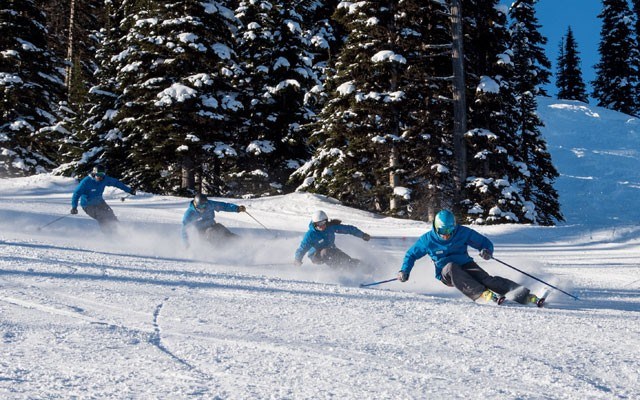A group from the Whistler Blackcomb (WB) Ski School hopes to take the rest of the world back to class.
WB will be represented at the Aspen World Synchronized Skiing Championships later this month with a squad led by team manager Guy Dale and head coach Russ Wood.
Whistler was once host to a major demo competition, the Battle of the Ski Schools, which ran for 15 years before wrapping in 2002.
"Back in the '90s, Whistler did this whole battle of the ski schools. It was huge. We had everybody. We had Aspen, guys from out east, (and) all the main players nowadays — Vail, Beaver Creek and I think Park City showed up a couple of times," Dale said. "I don't know what happened, actually. They just kind of stopped doing it. The whole culture of synchronized skiing just kind of disappeared. The whole performance of formation skiing just got kind of lost in Canada."
Dale became interested in synchronized skiing after meeting participants from other resorts and feeling Whistler should be represented on the world stage.
"I gave the guys an email this summer — I ski down in Australia with all these guys, one for the Telluride team, one from the Beaver Creek team. There's a guy from Davos in Switzerland and his team has been there and they're like 'Where the hell's Whistler, man? Biggest ski school in North America and they don't have a team coming down,'" Dale recalled.
Dale helped enlist Wood as the team's head coach and the crew quickly got down to business, organizing tryouts — with a surprisingly successful turnout of 35 athletes — and determining a plan of attack.
"It was kind of a rushed thing because we knew that the time was getting a little bit close," he said. "If we got a team together, we'd have to sort out funding and we'd have to actually practice before we went down there."
The competition will also feature bump skiing and racing, though the scores will be weighted to favour the synchro aspect of the event.
During the synchro part of competition, each of the four runs typically features the skiers performing four changes in formation on a relatively small course, Dale explained.
"We're judged on the speed, the performance and the technique and how difficult the manoeuvre is, so you've got the really easy ones where you have two lines of people and you just do opposite turns in sync and then you've got the really difficult ones — crash, for example — where you're in two different lines and you go very, very fast and you literally go right into each other. You've got the tail of one ski and then the tip of another."
When planning manoeuvres, Dale and Wood scour YouTube to look at what other countries are doing, and with the Canadian style emphasizing strength and efficiency in mind, plan their runs with the rest of the team.
"Two of us have taken the reins, but it's a group decision on where are we going to place what, how are we going to do it, who should lead. We mix it up. We'll try this manoeuvre with these leaders and then we'll swap it because some people may like to follow somebody else," Dale explained. "Basically, which order works the best to make it look as smooth and as energetic as we want it to look?"
After blocking off Tuesday mornings before work to train from the start of the season, the team members had their first full-day practice in late February and plan to train as often as their schedules will allow.
"The calibre of skiers that are on the team are in demand. It's very hard to get everybody there," Dale said.
Event organizers have sent out the course dimensions to the competitors, and so the Whistler squad has sought to replicate the conditions as closely as possible.
"We're trying to focus on skiing pretty much the same type of pitch. The top bit of Green Acres, the first steeper pitch is close to the dimensions of the ski hill down in Aspen," Dale said. "We do a lot of green chair runs — Orange Peel, Franz's is a good run.
"The actual run is only about 300 metres long, so it's actually shorter than you think, especially when you're travelling quite fast."
Team member Christian Aigner, originally hailing from Austria where demo competitions are commonplace, said the increase in training will be welcome as the skiers all look to pin down precise passes.
"We are all highly qualified, but now it's time to put that together as a team," Aigner said. "We don't know each other that well skiing-wise, so we need to start reading body language to see when the other person is actually going to turn."
Dale hopes the team's venture down to Colorado is just the tip of the iceberg for the sport here in the resort, eventually hoping to host an event once again.
"I would like to grow this kind of culture and the team," Dale said. "Maybe next year we could have a Whistler women's team again.
"In two or three years, maybe we could bring a competition back to Whistler."
The team has started a RallyMe campaign to try to cover its costs of attending the competition. Those looking to support the crew or donate can visit www.rallyme.com/rallies/3195/teamwhistler. As of March 9, the team had raised just over $1,285 of its $7,500 goal.
The team also includes Dom Ethier, Tom Francis, Dick Nott, Marie-Claude Baron, J.S. Forget, Ben Darlow and Tracey Fraser.




